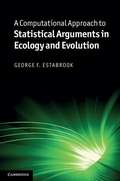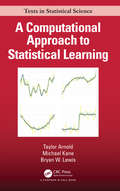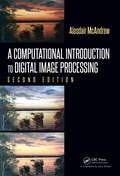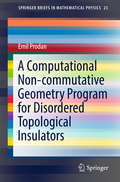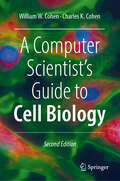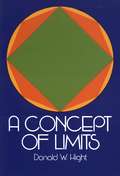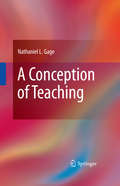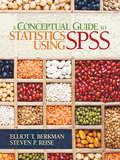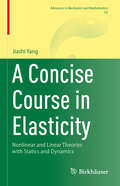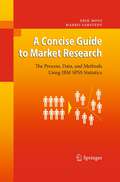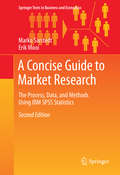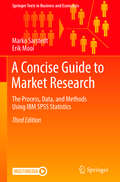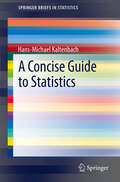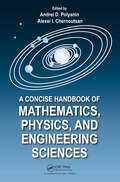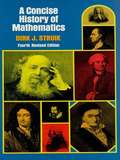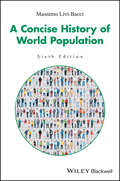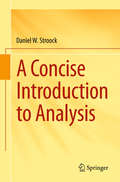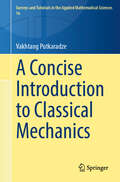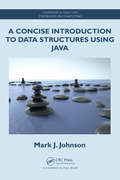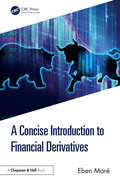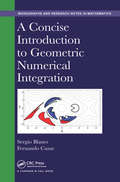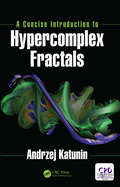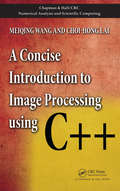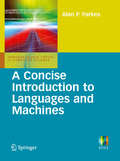- Table View
- List View
A Computational Approach to Statistical Arguments in Ecology and Evolution
by George EstabrookScientists need statistics. Increasingly this is accomplished using computational approaches. Freeing readers from the constraints, mysterious formulas and sophisticated mathematics of classical statistics, this book is ideal for researchers who want to take control of their own statistical arguments. It demonstrates how to use spreadsheet macros to calculate the probability distribution predicted for any statistic by any hypothesis. This enables readers to use anything that can be calculated (or observed) from their data as a test statistic and hypothesize any probabilistic mechanism that can generate data sets similar in structure to the one observed. A wide range of natural examples drawn from ecology, evolution, anthropology, palaeontology and related fields give valuable insights into the application of the described techniques, while complete example macros and useful procedures demonstrate the methods in action and provide starting points for readers to use or modify in their own research.
A Computational Approach to Statistical Arguments in Ecology and Evolution
by George F. EstabrookScientists need statistics. Increasingly this is accomplished using computational approaches. Freeing readers from the constraints, mysterious formulas and sophisticated mathematics of classical statistics, this book is ideal for researchers who want to take control of their own statistical arguments. It demonstrates how to use spreadsheet macros to calculate the probability distribution predicted for any statistic by any hypothesis. This enables readers to use anything that can be calculated (or observed) from their data as a test statistic and hypothesize any probabilistic mechanism that can generate data sets similar in structure to the one observed. A wide range of natural examples drawn from ecology, evolution, anthropology, palaeontology and related fields give valuable insights into the application of the described techniques, while complete example macros and useful procedures demonstrate the methods in action and provide starting points for readers to use or modify in their own research.
A Computational Approach to Statistical Learning (Chapman And Hall/crc Texts In Statistical Science Ser.)
by Michael Kane Taylor Arnold Bryan W. LewisA Computational Approach to Statistical Learning gives a novel introduction to predictive modeling by focusing on the algorithmic and numeric motivations behind popular statistical methods. The text contains annotated code to over 80 original reference functions. These functions provide minimal working implementations of common statistical learning algorithms. Every chapter concludes with a fully worked out application that illustrates predictive modeling tasks using a real-world dataset. The text begins with a detailed analysis of linear models and ordinary least squares. Subsequent chapters explore extensions such as ridge regression, generalized linear models, and additive models. The second half focuses on the use of general-purpose algorithms for convex optimization and their application to tasks in statistical learning. Models covered include the elastic net, dense neural networks, convolutional neural networks (CNNs), and spectral clustering. A unifying theme throughout the text is the use of optimization theory in the description of predictive models, with a particular focus on the singular value decomposition (SVD). Through this theme, the computational approach motivates and clarifies the relationships between various predictive models.
A Computational Introduction to Digital Image Processing
by Alasdair McAndrewHighly Regarded, Accessible Approach to Image Processing Using Open-Source and Commercial SoftwareA Computational Introduction to Digital Image Processing, Second Edition explores the nature and use of digital images and shows how they can be obtained, stored, and displayed. Taking a strictly elementary perspective, the book only covers topics that
A Computational Non-commutative Geometry Program for Disordered Topological Insulators (SpringerBriefs in Mathematical Physics #23)
by Emil ProdanThis work presents a computational program based on the principles of non-commutative geometry and showcases several applications to topological insulators. Noncommutative geometry has been originally proposed by Jean Bellissard as a theoretical framework for the investigation of homogeneous condensed matter systems. Recently, this approach has been successfully applied to topological insulators, where it facilitated many rigorous results concerning the stability of the topological invariants against disorder. In the first part of the book the notion of a homogeneous material is introduced and the class of disordered crystals defined together with the classification table, which conjectures all topological phases from this class. The manuscript continues with a discussion of electrons' dynamics in disordered crystals and the theory of topological invariants in the presence of strong disorder is briefly reviewed. It is shown how all this can be captured in the language of noncommutative geometry using the concept of non-commutative Brillouin torus, and a list of known formulas for various physical response functions is presented. In the second part, auxiliary algebras are introduced and a canonical finite-volume approximation of the non-commutative Brillouin torus is developed. Explicit numerical algorithms for computing generic correlation functions are discussed. In the third part upper bounds on the numerical errors are derived and it is proved that the canonical-finite volume approximation converges extremely fast to the thermodynamic limit. Convergence tests and various applications concludes the presentation. The book is intended for graduate students and researchers in numerical and mathematical physics.
A Computer Scientist's Guide to Cell Biology
by William W. Cohen Charles K. CohenUnlike the structured world of computer science, biology is complex, evolving, and often lacks clean abstract models. This book aims to serve as a guide for computer scientists who need to understand cell biology, breaking the field into three parts: biological mechanics, experimental methods, and language/nomenclature. While biological mechanics, which investigates cellular-level details, is covered by many texts, this book also focuses on experimental methods – how biologists conduct experiments and gather data - and on helping the reader understand the language and terminology of biology, which is rich but challenging for non-biologists. A Computer Scientist's Guide to Cell Biology uses a metaphor of biology as a strange land with an unfamiliar language and customs. The goal of the book is to provide a high-level introduction to cell biology, simplifying concepts and relating them to familiar ideas from computer science, so that working computer scientists can more effectively understand read recent research papers and results.This Second Edition contains a number of updates, including discussions of CRISPR, advances in DNA Sequencing, and mRNA vaccines. It serves as an easy-to-read travel guide for computer scientists navigating the intricate and sometimes perplexing terrain of cell biology, offering insights into experimental methods and helping bridge the gap between the structured world of computer science and the complexities of biological systems.
A Concept of Limits (Dover Books on Mathematics)
by Donald W. HightAn exploration of conceptual foundations and the practical applications of limits in mathematics, this text offers a concise introduction to the theoretical study of calculus. It analyzes the idea of a generalized limit and explains sequences and functions to those for whom intuition cannot suffice. Many exercises with solutions. 1966 edition.
A Conception of Teaching
by Nathaniel L. GageThe literature of the behavioural and social sciences is full of theory and research on learning and memory. Teaching is comparatively a stepchild, neglected by those who have built a formidable body of theories of learning and memory. However, teaching is where learning and memory theory should pay off. "A Conception of Teaching" dedicates a chapter to each of the following important components: the need for a theory; the possibility of a theory; the evolution of a paradigm for the study of teaching; a conception of the process of teaching; a conception of the content of teaching; a conception of students' cognitive capabilities and motivations; a conception of classroom management; and the integration of these conceptions. Written in a highly accessible style, while maintaining a base in research, Dr. Nathaniel L. Gage presents "A Conception of Teaching" with clarity and well situated within current educational debates.
A Conceptual Guide to Statistics Using SPSS
by Steven P. Reise Elliot T. BerkmanBridging an understanding of Statistics and SPSS.This unique text helps students develop a conceptual understanding of a variety of statistical tests by linking the ideas learned in a statistics class from a traditional statistics textbook with the computational steps and output from SPSS. Each chapter begins with a student-friendly explanation of the concept behind each statistical test and how the test relates to that concept. The authors then walk through the steps to compute the test in SPSS and the output, clearly linking how the SPSS procedure and output connect back to the conceptual underpinnings of the test. By drawing clear connections between the theoretical and computational aspects of statistics, this engaging text aids students' understanding of theoretical concepts by teaching them in a practical context.
A Concise Course in Elasticity: Nonlinear and Linear Theories with Statics and Dynamics (Advances in Mechanics and Mathematics #54)
by Jiashi YangThis textbook presents a concise and comprehensive treatment of the theory of elasticity. It covers both the linear and nonlinear aspects of the theory, including both statics and dynamics. Written to be accessible to the graduate student reader, this text promotes approachability by minimizing the use of complex mathematical tools, and instead emphasizing the formulation of the initial boundary value problems. This approach makes it an ideal resource for students as well as instructors seeking a textbook designed for a one-semester graduate course in elasticity. Divided into ten chapters, the book begins with a brief review of the mechanics of materials. The theory of Cartesian tensors is then introduced, which serves as a mathematical preparation for the concise treatment of the nonlinear theory of elasticity that follows. The theory of linear elasticity is covered next with the remainder of the book then focusing on problem solving in linear elasticity. These chapters cover topics such as antiplane problems, plane-stress and plane-strain problems, and elastodynamics. Five appendices appear at the end, which include basic equations of elasticity in cylindrical, polar, and spherical coordinates, as well as a collection of vector identities that appear throughout the book. A Concise Course in Elasticity is an ideal textbook for a one-semester graduate course on elasticity. Graduate students interested in this topic will appreciate the author’s accessible approach. Instructors will find the comprehensive coverage uniquely suited to providing an overview of the area. Readers are assumed to have some experience at the undergraduate level of the mechanics of materials.
A Concise Guide to Market Research: The Process, Data, and Methods Using IBM SPSS Statistics (Springer Texts in Business and Economics)
by Erik Mooi Marko SarstedtThis accessible, practice-oriented and compact text provides a hands-on introduction to the principles of market research. Using the market research process as a framework, the authors explain how to collect and describe the necessary data and present the most important and frequently used quantitative analysis techniques, such as ANOVA, regression analysis, factor analysis, and cluster analysis. An explanation is provided of the theoretical choices a market researcher has to make with regard to each technique, as well as how these are translated into actions in IBM SPSS Statistics. This includes a discussion of what the outputs mean and how they should be interpreted from a market research perspective. Each chapter concludes with a case study that illustrates the process based on real-world data. A comprehensive web appendix includes additional analysis techniques, datasets, video files and case studies. Several mobile tags in the text allow readers to quickly browse related web content using a mobile device.
A Concise Guide to Market Research: The Process, Data, and Methods Using IBM SPSS Statistics (Springer Texts in Business and Economics)
by Erik Mooi Marko SarstedtThis accessible, practice-oriented and compact text provides a hands-on introduction to market research. Using the market research process as a framework, it explains how to collect and describe data and presents the most important and frequently used quantitative analysis techniques, such as ANOVA, regression analysis, factor analysis and cluster analysis. The book describes the theoretical choices a market researcher has to make with regard to each technique, discusses how these are converted into actions in IBM SPSS version 22 and how to interpret the output. Each chapter concludes with a case study that illustrates the process using real-world data. A comprehensive Web appendix includes additional analysis techniques, datasets, video files and case studies. Tags in the text allow readers to quickly access Web content with their mobile device. The new edition features: Stronger emphasis on the gathering and analysis of secondary data (e. g. , internet and social networking data) New material on data description (e. g. , outlier detection and missing value analysis) Improved use of educational elements such as learning objectives, keywords, self-assessment tests, case studies, and much more Streamlined and simplified coverage of the data analysis techniques with more rules-of-thumb Uses IBM SPSS version 22
A Concise Guide to Market Research: The Process, Data, and Methods Using IBM SPSS Statistics (Springer Texts in Business and Economics)
by Erik Mooi Marko SarstedtThis book offers an easily accessible and comprehensive guide to the entire market research process, from asking market research questions to collecting and analyzing data by means of quantitative methods. It is intended for all readers who wish to know more about the market research process, data management, and the most commonly used methods in market research. The book helps readers perform analyses, interpret the results, and make sound statistical decisions using IBM SPSS Statistics. Hypothesis tests, ANOVA, regression analysis, principal component analysis, factor analysis, and cluster analysis, as well as essential descriptive statistics, are covered in detail. Highly engaging and hands-on, the book includes many practical examples, tips, and suggestions that help readers apply and interpret the data analysis methods discussed. The new edition uses IBM SPSS version 25 and offers the following new features:A single case and dataset used throughout the book to facilitate learningNew material on survey design and all data analysis methods to reflect the latest advances concerning each topicImproved use of educational elements, such as learning objectives, keywords, self-assessment tests, case studies, and much moreA glossary that includes definitions of all the keywords and other descriptions of selected topics Links to additional material and videos via the Springer Multimedia App
A Concise Guide to Statistics (SpringerBriefs in Statistics)
by Hans-Michael KaltenbachThe text gives a concise introduction into fundamental concepts in statistics. Chapter 1: Short exposition of probability theory, using generic examples. Chapter 2: Estimation in theory and practice, using biologically motivated examples. Maximum-likelihood estimation in covered, including Fisher information and power computations. Methods for calculating confidence intervals and robust alternatives to standard estimators are given. Chapter 3: Hypothesis testing with emphasis on concepts, particularly type-I , type-II errors, and interpreting test results. Several examples are provided. T-tests are used throughout, followed important other tests and robust/nonparametric alternatives. Multiple testing is discussed in more depth, and combination of independent tests is explained. Chapter 4: Linear regression, with computations solely based on R. Multiple group comparisons with ANOVA are covered together with linear contrasts, again using R for computations.
A Concise Handbook of Mathematics, Physics, and Engineering Sciences
by Andrei D. Polyanin Alexei ChernoutsanA Concise Handbook of Mathematics, Physics, and Engineering Sciences takes a practical approach to the basic notions, formulas, equations, problems, theorems, methods, and laws that most frequently occur in scientific and engineering applications and university education. The authors pay special attention to issues that many engineers and students
A Concise History of Mathematics: Fourth Revised Edition (Dover Books on Mathematics)
by Dirk J. StruikThis compact, well-written history -- first published in 1948, and now in its fourth revised edition -- describes the main trends in the development of all fields of mathematics from the first available records to the middle of the 20th century. Students, researchers, historians, specialists -- in short, everyone with an interest in mathematics -- will find it engrossing and stimulating.Beginning with the ancient Near East, the author traces the ideas and techniques developed in Egypt, Babylonia, China, and Arabia, looking into such manuscripts as the Egyptian Papyrus Rhind, the Ten Classics of China, and the Siddhantas of India. He considers Greek and Roman developments from their beginnings in Ionian rationalism to the fall of Constantinople; covers medieval European ideas and Renaissance trends; analyzes 17th- and 18th-century contributions; and offers an illuminating exposition of 19th century concepts. Every important figure in mathematical history is dealt with -- Euclid, Archimedes, Diophantus, Omar Khayyam, Boethius, Fermat, Pascal, Newton, Leibniz, Fourier, Gauss, Riemann, Cantor, and many others. For this latest edition, Dr. Struik has both revised and updated the existing text, and also added a new chapter on the mathematics of the first half of the 20th century. Concise coverage is given to set theory, the influence of relativity and quantum theory, tensor calculus, the Lebesgue integral, the calculus of variations, and other important ideas and concepts. The book concludes with the beginnings of the computer era and the seminal work of von Neumann, Turing, Wiener, and others."The author's ability as a first-class historian as well as an able mathematician has enabled him to produce a work which is unquestionably one of the best." -- Nature Magazine.
A Concise History of World Population
by Massimo Livi BacciThe latest edition of this classic text has been updated to reflect current trends and implications for future demographic developments. The areas of Africa, international migration and population and environment have been strengthened and statistical information has been updated throughout. A new edition of this classic history of demography text, which has been updated to strengthen the major subject areas of Africa, international migration and population and the environment Includes the latest statistical information, including the 2015 UN population projections revision and developments in China's population policy Information is presented in a clear and simple form, with academic material presented accessibly for the undergraduate audience whilst still maintaining the interest of higher level students and scholars The text covers issues that are crucial to the future of every species by encouraging humanity's search for ways to prevent future demographic catastrophes brought about by environmental or human agency Analyses the changing patterns of world population growth, including the effects of migration, war, disease, technology and culture
A Concise Introduction to Analysis
by Daniel W. StroockThis book provides an introduction to the basic ideas and tools used in mathematical analysis. It is a hybrid cross between an advanced calculus and a more advanced analysis text and covers topics in both real and complex variables. Considerable space is given to developing Riemann integration theory in higher dimensions, including a rigorous treatment of Fubini's theorem, polar coordinates and the divergence theorem. These are used in the final chapter to derive Cauchy's formula, which is then applied to prove some of the basic properties of analytic functions. Among the unusual features of this book is the treatment of analytic function theory as an application of ideas and results in real analysis. For instance, Cauchy's integral formula for analytic functions is derived as an application of the divergence theorem. The last section of each chapter is devoted to exercises that should be viewed as an integral part of the text. A Concise Introduction to Analysis should appeal to upper level undergraduate mathematics students, graduate students in fields where mathematics is used, as well as to those wishing to supplement their mathematical education on their own. Wherever possible, an attempt has been made to give interesting examples that demonstrate how the ideas are used and why it is important to have a rigorous grasp of them.
A Concise Introduction to Classical Mechanics (Surveys and Tutorials in the Applied Mathematical Sciences #16)
by Vakhtang PutkaradzeMechanics is one of the oldest and most foundational subjects in undergraduate curricula for mathematicians, physicists, and engineers. Traditionally taught through a classical, or "analytical," approach, modern advancements have introduced a "geometric" perspective that has found applications in diverse fields such as machine learning, climate research, satellite navigation, and more. This book bridges the gap between classical mechanics and its modern, geometric counterpart. Designed for students and educators, it presents the essential topics typically required in mechanics courses while integrating a geometric approach to deepen understanding. Key features include: *Clear explanations of core concepts, including Lagrangian mechanics, variational methods, canonical transformations, and systems with constraints. *Numerous solved problems and real-world examples to solidify understanding. *Sample midterms and final exams to help students prepare for coursework and assessments. *Every chapter includes a &‘looking forward&’ section outlining modern applications of the material. The book minimizes mathematical abstraction, introducing only the necessary concepts to make the material accessible and practical. Whether you're a student looking to master the essentials or an instructor seeking a fresh perspective, this book provides a comprehensive, approachable, and modern exploration of mechanics.
A Concise Introduction to Data Structures using Java (Chapman And Hall/crc Textbooks In Computing Ser. #11)
by Mark J. JohnsonA student-friendly text, A Concise Introduction to Data Structures Using Java takes a developmental approach, starting with simpler concepts first and then building toward greater complexity. Important topics, such as linked lists, are introduced gradually and revisited with increasing depth. More code and guidance are provided at the beginning, al
A Concise Introduction to Financial Derivatives
by Eben MaréA Concise Introduction to Financial Derivatives seeks to present financial derivatives in a manner that requires minimal mathematical background. Readers will obtain, in a quick and engaging way, a working knowledge of the field and a collection of practical working insights. The book is ideal for aspiring young practitioners, advanced undergraduates, and masters-level students who require a concise and practice-led introduction to financial derivatives.Features:• Practical insights and modelling skills• Accessible to practitioners and students without a significant mathematical backgroundEben Maré holds responsibility for absolute return portfolio management and has been working in the financial markets for the last 33 years. He has also held senior roles in risk management, treasury, derivatives trading, and asset management. He has a PhD in Applied Mathematics and is an associate professor in Mathematics and Applied Mathematics at the University of Pretoria in South Africa. He has wide research interests in financial derivatives, asset management, and financial markets.
A Concise Introduction to Geometric Numerical Integration (Chapman & Hall/CRC Monographs and Research Notes in Mathematics #23)
by Fernando Casas Sergio BlanesDiscover How Geometric Integrators Preserve the Main Qualitative Properties of Continuous Dynamical Systems <P><P>A Concise Introduction to Geometric Numerical Integration presents the main themes, techniques, and applications of geometric integrators for researchers in mathematics, physics, astronomy, and chemistry who are already familiar with numerical tools for solving differential equations. It also offers a bridge from traditional training in the numerical analysis of differential equations to understanding recent, advanced research literature on numerical geometric integration. <P><P>The book first examines high-order classical integration methods from the structure preservation point of view. It then illustrates how to construct high-order integrators via the composition of basic low-order methods and analyzes the idea of splitting. It next reviews symplectic integrators constructed directly from the theory of generating functions as well as the important category of variational integrators. The authors also explain the relationship between the preservation of the geometric properties of a numerical method and the observed favorable error propagation in long-time integration. The book concludes with an analysis of the applicability of splitting and composition methods to certain classes of partial differential equations, such as the Schrödinger equation and other evolution equations. <P><P>The motivation of geometric numerical integration is not only to develop numerical methods with improved qualitative behavior but also to provide more accurate long-time integration results than those obtained by general-purpose algorithms. Accessible to researchers and post-graduate students from diverse backgrounds, this introductory book gets readers up to speed on the ideas, methods, and applications of this field. Readers can reproduce the figures and results given in the text using the MATLAB® programs and model files available online.
A Concise Introduction to Hypercomplex Fractals
by Andrzej KatuninThis book presents concisely the full story on complex and hypercomplex fractals, starting from the very first steps in complex dynamics and resulting complex fractal sets, through the generalizations of Julia and Mandelbrot sets on a complex plane and the Holy Grail of the fractal geometry – a 3D Mandelbrot set, and ending with hypercomplex, multicomplex and multihypercomplex fractal sets which are still under consideration of scientists. I tried to write this book in a possibly simple way in order to make it understandable to most people whose math knowledge covers the fundamentals of complex numbers only. Moreover, the book is full of illustrations of generated fractals and stories concerned with great mathematicians, number spaces and related fractals. In the most cases only information required for proper understanding of a nature of a given vector space or a construction of a given fractal set is provided, nevertheless a more advanced reader may treat this book as a fundamental compendium on hypercomplex fractals with references to purely scientific issues like dynamics and stability of hypercomplex systems.
A Concise Introduction to Image Processing using C++ (Chapman & Hall/CRC Numerical Analysis and Scientific Computing Series)
by Meiqing Wang Choi-Hong LaiImage recognition has become an increasingly dynamic field with new and emerging civil and military applications in security, exploration, and robotics. Written by experts in fractal-based image and video compression, A Concise Introduction to Image Processing using C++ strengthens your knowledge of fundamentals principles in image acquisition, conservation, processing, and manipulation, allowing you to easily apply these techniques in real-world problems. The book presents state-of-the-art image processing methodology, including current industrial practices for image compression, image de-noising methods based on partial differential equations (PDEs), and new image compression methods, such as fractal image compression and wavelet compression. It begins with coverage of representation, and then moves on to communications and processing. It concludes with discussions of processing techniques based on image representations and transformations developed in earlier chapters. The accompanying downloadable resources contain code for all algorithms.Suitable as a text for any course on image processing, the book can also be used as a self-study resource for researchers who need a concise and clear view of current image processing methods and coding examples. The authors introduce mathematical concepts with rigor suitable for readers with some background in calculus, algebra, geometry, and PDEs. All algorithms described are illustrated with code implementation and many images compare the results of different methods. The inclusion of C++ implementation code for each algorithm described enables students and practitioners to build up their own analysis tool.
A Concise Introduction to Languages and Machines (Undergraduate Topics in Computer Science)
by Alan P. ParkesA Concise Introduction to Languages, Machines and Logic provides an accessible introduction to three key topics within computer science: formal languages, abstract machines and formal logic. Written in an easy-to-read, informal style, this textbook assumes only a basic knowledge of programming on the part of the reader. The approach is deliberately non-mathematical, and features: - Clear explanations of formal notation and jargon, - Extensive use of examples to illustrate algorithms and proofs, - Pictorial representations of key concepts, - Chapter opening overviews providing an introduction and guidance to each topic, - End-of-chapter exercises and solutions, - Offers an intuitive approach to the topics. This reader-friendly textbook has been written with undergraduates in mind and will be suitable for use on course covering formal languages, formal logic, computability and automata theory. It will also make an excellent supplementary text for courses on algorithm complexity and compilers.
